Index by author
Mamourian, A.
- LetterYou have accessImpact on Quality of Neuroradiology Interpretations by CaseloadA. MamourianAmerican Journal of Neuroradiology November 2019, 40 (11) E64; DOI: https://doi.org/10.3174/ajnr.A6229
Mccollough, C.H.
- FELLOWS' JOURNAL CLUBPatient SafetyOpen AccessEvaluation of Lower-Dose Spiral Head CT for Detection of Intracranial Findings Causing Neurologic DeficitsJ.G. Fletcher, D.R. DeLone, A.L. Kotsenas, N.G. Campeau, V.T. Lehman, L. Yu, S. Leng, D.R. Holmes, P.K. Edwards, M.P. Johnson, G.J. Michalak, R.E. Carter and C.H. McColloughAmerican Journal of Neuroradiology November 2019, 40 (11) 1855-1863; DOI: https://doi.org/10.3174/ajnr.A6251
Projection data from 83 patients undergoing unenhanced spiral head CT for suspected neurologic deficits were collected. A routine dose was obtained using 250 effective mAs and iterative reconstruction. Lower-dose configurations were reconstructed (25-effective mAs iterative reconstruction, 50-effective mAs filtered back-projection and iterative reconstruction, 100-effective mAs filtered back-projection and iterative reconstruction, 200-effective mAs filtered back-projection). Three neuroradiologists circled findings, indicating diagnosis, confidence, and image quality. The routine-dose jackknife alternative free-response receiver operating characteristic figure of merit was 0.87. Noninferiority was shown for 100-effective mAs iterative reconstruction and 200-effective mAs filtered back-projection, but not for100-effective mAs filtered back-projection. The authors conclude that substantial opportunity exists for dose reduction using spiral nonenhanced head CT and that the dose level might potentially be reduced to 40% of routine dose levels or a volume CT dose index of approximately 15mGy if slight decreases in performance are acceptable. The beneficial effect of iterative reconstrution was most pronounced at this 15-mGy dose level.
Meng, H.
- NeurointerventionOpen AccessNovel Models for Identification of the Ruptured Aneurysm in Patients with Subarachnoid Hemorrhage with Multiple AneurysmsH. Rajabzadeh-Oghaz, J. Wang, N. Varble, S.-I. Sugiyama, A. Shimizu, L. Jing, J. Liu, X. Yang, A.H. Siddiqui, J.M. Davies and H. MengAmerican Journal of Neuroradiology November 2019, 40 (11) 1939-1946; DOI: https://doi.org/10.3174/ajnr.A6259
Michalak, G.J.
- FELLOWS' JOURNAL CLUBPatient SafetyOpen AccessEvaluation of Lower-Dose Spiral Head CT for Detection of Intracranial Findings Causing Neurologic DeficitsJ.G. Fletcher, D.R. DeLone, A.L. Kotsenas, N.G. Campeau, V.T. Lehman, L. Yu, S. Leng, D.R. Holmes, P.K. Edwards, M.P. Johnson, G.J. Michalak, R.E. Carter and C.H. McColloughAmerican Journal of Neuroradiology November 2019, 40 (11) 1855-1863; DOI: https://doi.org/10.3174/ajnr.A6251
Projection data from 83 patients undergoing unenhanced spiral head CT for suspected neurologic deficits were collected. A routine dose was obtained using 250 effective mAs and iterative reconstruction. Lower-dose configurations were reconstructed (25-effective mAs iterative reconstruction, 50-effective mAs filtered back-projection and iterative reconstruction, 100-effective mAs filtered back-projection and iterative reconstruction, 200-effective mAs filtered back-projection). Three neuroradiologists circled findings, indicating diagnosis, confidence, and image quality. The routine-dose jackknife alternative free-response receiver operating characteristic figure of merit was 0.87. Noninferiority was shown for 100-effective mAs iterative reconstruction and 200-effective mAs filtered back-projection, but not for100-effective mAs filtered back-projection. The authors conclude that substantial opportunity exists for dose reduction using spiral nonenhanced head CT and that the dose level might potentially be reduced to 40% of routine dose levels or a volume CT dose index of approximately 15mGy if slight decreases in performance are acceptable. The beneficial effect of iterative reconstrution was most pronounced at this 15-mGy dose level.
Mirsky, D.M.
- Pediatric NeuroimagingYou have accessAge-Dependent Signal Intensity Changes in the Structurally Normal Pediatric Brain on Unenhanced T1-Weighted MR ImagingT.F. Flood, P.R. Bhatt, A. Jensen, J.A. Maloney, N.V. Stence and D.M. MirskyAmerican Journal of Neuroradiology November 2019, 40 (11) 1824-1828; DOI: https://doi.org/10.3174/ajnr.A6254
Molavi, M.
- Pediatric NeuroimagingOpen AccessSignal Change in the Mammillary Bodies after Perinatal AsphyxiaM. Molavi, S.D. Vann, L.S. de Vries, F. Groenendaal and M. LequinAmerican Journal of Neuroradiology November 2019, 40 (11) 1829-1834; DOI: https://doi.org/10.3174/ajnr.A6232
Morris, P.
- Pediatric NeuroimagingYou have accessMixed Solid and Cystic Mass in an InfantJ.C. Benson, D. Summerfield, J.B. Guerin, D. Kun Kim, L. Eckel, D.J. Daniels and P. MorrisAmerican Journal of Neuroradiology November 2019, 40 (11) 1792-1795; DOI: https://doi.org/10.3174/ajnr.A6226
Mueller, S.
- Pediatric NeuroimagingOpen AccessDiffusion Characteristics of Pediatric Diffuse Midline Gliomas with Histone H3-K27M Mutation Using Apparent Diffusion Coefficient Histogram AnalysisM.S. Aboian, E. Tong, D.A. Solomon, C. Kline, A. Gautam, A. Vardapetyan, B. Tamrazi, Y. Li, C.D. Jordan, E. Felton, B. Weinberg, S. Braunstein, S. Mueller and S. ChaAmerican Journal of Neuroradiology November 2019, 40 (11) 1804-1810; DOI: https://doi.org/10.3174/ajnr.A6302
Mynarek, M.
- Pediatric NeuroimagingYou have accessImaging Characteristics of Wingless Pathway Subgroup Medulloblastomas: Results from the German HIT/SIOP-Trial CohortA. Stock, M. Mynarek, T. Pietsch, S.M. Pfister, S.C. Clifford, T. Goschzik, D. Sturm, E.C. Schwalbe, D. Hicks, S. Rutkowski, B. Bison, M. Pham and M. Warmuth-MetzAmerican Journal of Neuroradiology November 2019, 40 (11) 1811-1817; DOI: https://doi.org/10.3174/ajnr.A6286
Naggara, O.
- FELLOWS' JOURNAL CLUBPediatric NeuroimagingYou have accessIncidental Brain MRI Findings in Children: A Systematic Review and Meta-AnalysisV. Dangouloff-Ros, C.-J. Roux, G. Boulouis, R. Levy, N. Nicolas, C. Lozach, D. Grevent, F. Brunelle, N. Boddaert and O. NaggaraAmerican Journal of Neuroradiology November 2019, 40 (11) 1818-1823; DOI: https://doi.org/10.3174/ajnr.A6281
Seven studies were included, reporting 5938 children (mean age, 11.3 ± 2.8 years). Incidental findings were present in 16.4% of healthy children, intracranial cysts being the most frequent (10.2%). Nonspecific white matter hyperintensities were reported in 1.9%, Chiari I malformation was found in 0.8%, and intracranial neoplasms were reported in 0.2%. In total, the prevalence of incidental findings needing follow-up was 2.6%. The prevalence of incidental findings is much more frequent in children than previously reported in adults, but clinically significant incidental findings were present in <1 in 38 children.








